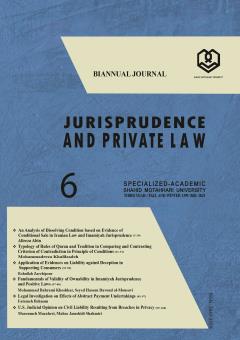-
-
-
Open Access Article
1 - Mortgage of Jointly Owned Property in the Jurisprudence of Five Religious Schools of Law and in Iranian Law
Saeed FarsadAbstract: Mortgage of jointly owned property (indivisum) is permissible according to Imamiyah, Maliki, Shafi’i, and Hanbali (except Hanafi) schools of Law because it is an instance of the rule of dominion. This is because conclusion of the mortgage contract does not mea MoreAbstract: Mortgage of jointly owned property (indivisum) is permissible according to Imamiyah, Maliki, Shafi’i, and Hanbali (except Hanafi) schools of Law because it is an instance of the rule of dominion. This is because conclusion of the mortgage contract does not mean possession of the jointly owned property. It is clear that submission of the jointly owned property to the mortgagee, in cases where it requires possession of the shares of the other partners, requires obtaining their consent. In cases where the mortgager submits the property to the mortgagee without the consent of the other partners, he shall be considered legally responsible for that. However, in cases where the submission of property means evacuation, the submission of the property does not mean possession of the shares of other partners, thus according to the jurisprudence of the above-said schools of law it does not need their consent for evacuation. This paper intends to study these issues in the jurisprudence of the abovementioned five schools of law and in the Iranian law. Manuscript profile -
Open Access Article
2 - A Study of the Procedures for Liquidating Bankrupt Banks (A Comparative Study of American and Iranian Legal Codes)
Mohammad Isai Tafreshi Khadijeh ShirvaniAbstract: It was after the 1929 Great Recession in the United States that the world economy suffered heavy losses and Iranian officials began paying attention to the bankruptcy of the banks and its highly negative impacts on the national economy. Consequently, the lawma MoreAbstract: It was after the 1929 Great Recession in the United States that the world economy suffered heavy losses and Iranian officials began paying attention to the bankruptcy of the banks and its highly negative impacts on the national economy. Consequently, the lawmakers came to the conclusion that rules and regulations on bankruptcy of the commercial corporations are not sufficient for verifying bankruptcy of the banks – which are considered commercial corporations in kind. On this basis, the United States has tried to consider certain rules and regulations for bankruptcy of banks, thanks to their role in national economy and their differences from the commercial corporations. The bankruptcy code for banks and financial institutions in the United States is called Resolution Regime. It is the government’s legal framework that resolves a failed bank in an orderly way to prevent the collapse of financial markets and the country’s financial system, to continue key services by the banks and to prevent the burden of bankruptcy on the government and taxpayers. In Iranian law, the bankruptcy regime of the banks is not a hundred percent apart from the bankruptcy of the corporations. In case of the bankruptcy of a bank, the Trade Law rules and regulations on bankruptcy will be considered as general rules and other monetary and banking rules and regulations will be particular ones. In case of the silence of the particular laws, the general rules and regulations will be applicable in case of the bankruptcy of the banks. In U.S. law, liquidation is the last step to deal with a bankrupt bank, while in Iranian law - since there is no substitute method for liquidation - the bankrupt bank starts liquidation immediately after receiving the order of bankruptcy. Manuscript profile
List of Articles Iranian law
-
The rights to this website are owned by the Raimag Press Management System.
Copyright © 2017-2024


